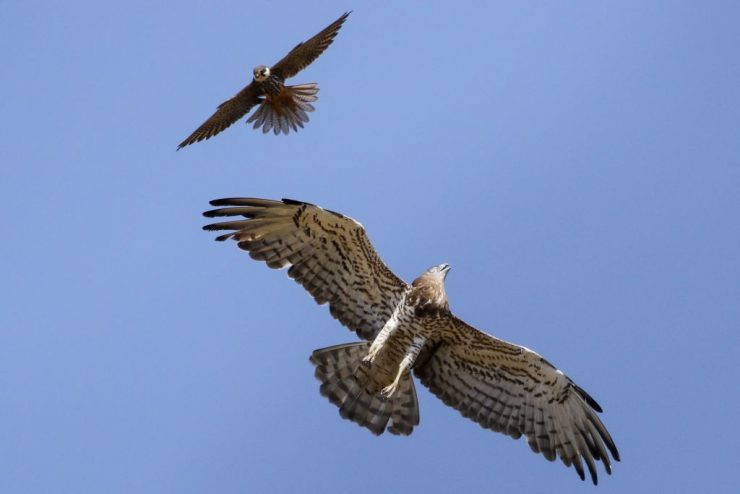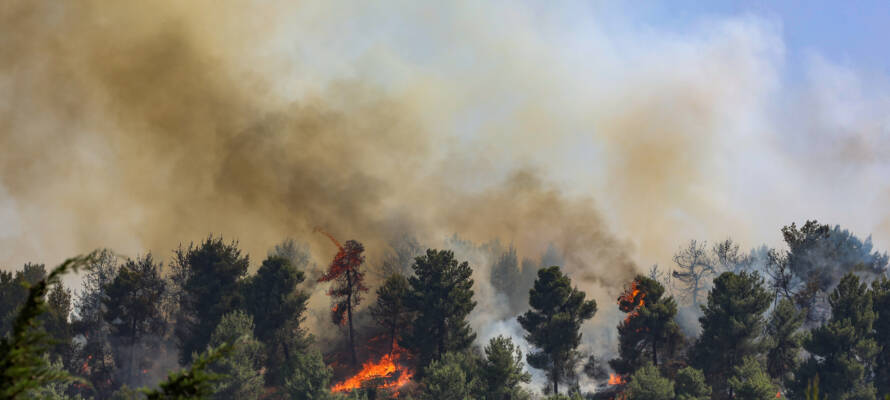Forest fires have consumed nearly 4,900 acres of Biriya forestland since the war began.
By Sveta Listratov, TPS
Nature in northern Israel is paying a heavy price as forest fires sparked by Hezbollah rocket attacks destroy vast tracts of woodland, causing irreparable harm to local wildlife.
In the Upper Galilee’s Biriya Forest these days, charred and barren trees dot the landscape. Blackened soil and scattered rocks show the steps of the wildfire’s advance. In the distance, a few trees still cling to life with browned and scorched foliage hinting at what once thrived here.
“This is the biggest challenge in the restoration of forests after the fires since the Second Lebanon War in 2006,” says Shali Ben Yishai, director of the Northern Region of Keren Kayemet LeIsrael-Jewish National Fund.
The once-lush forests of Northern Israel, home to diverse bird species and rich ecosystems have been ravaged by fires sparked by explosions and shrapnel from Hezbollah’s rockets and explosive drones.
The nearby forests of Bar’am and Meron endure equally severe damage.
But Biriya is the Galilee’s largest planted forest, covering an area of 20 sq. kilometers.
“Previously, Biriya Forest was dominated by oak trees. However, due to the intense fires, Biriya Forest will look different, more open. This will bring it closer to the state of mixed forests, meaning more broad-leaved trees, such as the Tabor oak, and the Carob, and natural woodland, which is not easy to achieve here,” Arthur Yankelov, the Biriya Forest Area Forester told The Press Service of Israel.
“The forests will take on a different shape, not like we’re used to seeing.”
In recent months, Yankelov, along with his colleagues from KKL-JNF, has been at the forefront of firefighting efforts. Their operations, which involve 26 fire trucks and 300 personnel, have been crucial in battling the blazes.
Despite their extensive efforts, at least 4,900 acres of Biriya forest land have been consumed by the fires since the war began.
But many other forests remain inaccessible due to ongoing military activities, and the full extent of the damage remains unknown.

A short-toed eagle (bottom) and a Eurasian hobby fly over the Upper Galilee’s Biriya’s Forest. Photo by Yaron Charka/KKL-JNF
The recent fires have had a devastating impact on both plant life and wildlife. Not only have they destroyed vast areas of forest, but they have also severely disrupted the food chain for many animals.
Reptiles, whose nests may survive, face food shortages in the barren landscape. The fires have particularly harmed bird populations.
“When forest fires naturally occur in the autumn, birds, who are adapted to it, simply fly away,” Yaron Charka, head ornithologist of KKL, explained.
“But when forest fires happen in a very unnatural way, like the current war, in spring, it’s the peak of the nesting season. The adults may fly away, but the chicks and nests with eggs burn, and we lose an entire generation.”
Particularly affected are nocturnal raptors like the eagle owl, whose nests are often hidden in tree cavities. The obliteration of its breeding grounds leaves the species in a dire situation, Charka said.
“We are currently engaged in research to map the eagle owl population by recording their calls, hoping to mitigate the long-term impacts on these birds,” Charka said.
Biriya Forest is a crucial habitat for other birds of prey, including the Eurasian hobby, a small swift falcon that has been red-listed due to its declining population.
The sparrowhawk, which began nesting in Israel in 1989, found a suitable environment among the mature pine trees of the KKL forests.
Since the late 1980s, the common hawk has expanded its nesting range across Israeli forests. Short-toed eagles are also found in Biriya.
“We estimate that approximately 20% of the forest area has burned, which translates to the destruction of dozens of nests,” Charka said.
For the foresters, the focus shifts to restoration efforts which will be a lengthy and complex process. Yankelov was on the ground battling the forest fires in Biriya in 2006 during the Second Lebanon War.
He draws on the lessons learned from that challenging time to guide today’s restoration efforts.
“The previous generation of foresters who invested in this forest saw their work burning to the ground, so we hope that our work will eventually last for a longer time,” Yankelov said.
“Back then, we thought it would be the last war. And here we are, having grown a forest from the last devastation, and we’ve returned to the same situation we started from,” he reflected with a sad smile.
“The forest taught me throughout my career that it does not grow overnight, like tomatoes or peppers. It takes time.”
Standing firm with his colleagues, he is devoted to the cause, determined to see it through to the very end.
Said Ben Yishai, “We have the patience for this; we have the patience to follow it, observe the natural processes, create and nurture a forest for future generations.”
Around 60,000 Israelis living in northern communities were forced to evacuate in October when the Hezbollah terror organization began daily rocket and drone attacks.
Leaders of the Iran-backed terror group have said they will continue the attacks to prevent Israelis from returning to their homes. Hezbollah attacks have killed 12 civilians and 17 soldiers.
Israeli officials have been calling for Hezbollah to be disarmed and removed from Southern Lebanon in accordance with UN Security Council resolution 1701, which ended the 2006 Second Lebanon War.
